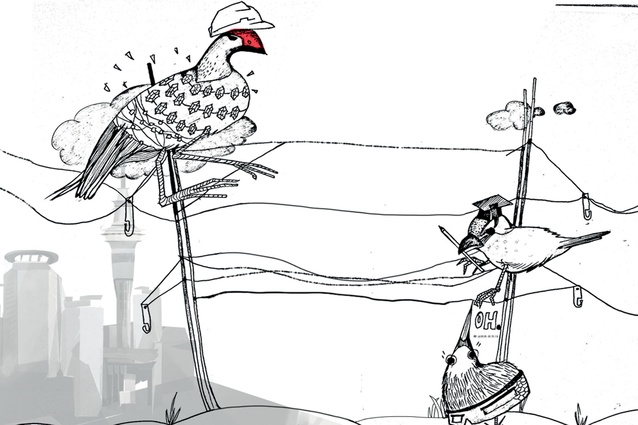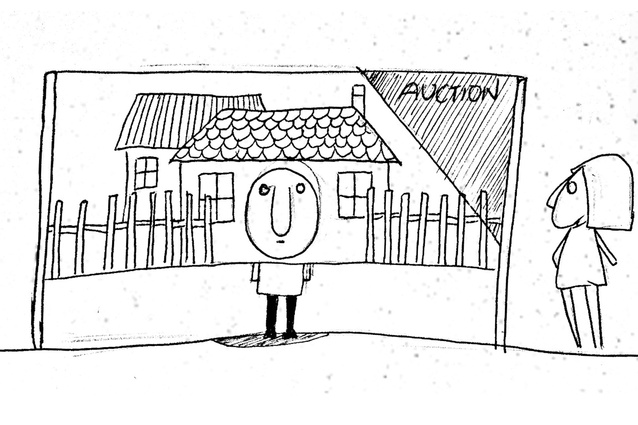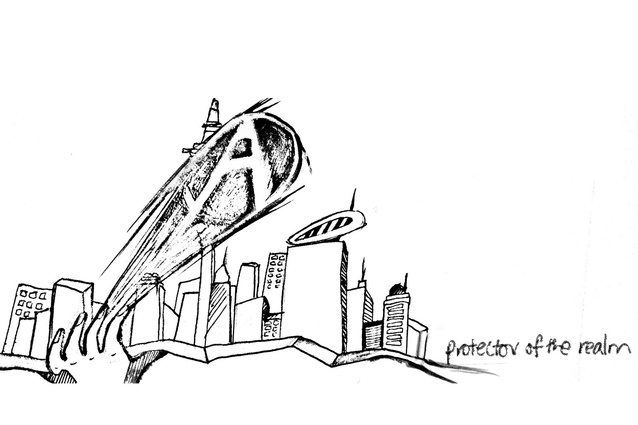Why the role of architects is on trial
If architecture has been subsumed as a profession, denigrated to a position beneath project managment and contracting in the pecking order, then the role of the architect is on trial. Here, Chris Kelly from Architecture Workshop suggests ways in which architects can remind and convince the public that the discipline of architecture is essential to the quality of civic life.
“The following code has been drawn up for the guidance of project managers in New Zealand and sets out the principles which should be observed by a project manager in his/her professional work. The code is similar to that of the New Zealand Institute of Project Managers. It is intended, rather, as a general guide, to define as far as practicable the spirit of ethical practice. There will be other cases of conduct, not included, which could reasonably be regarded as infringing the principals of the code and it will be for the Board to determine in any particular case whether a project manger has departed so seriously from the principles of conduct laid down in the code as to be guilty of ‘infamous conduct in a professional respect’.”
– Project Managers (amendment) Act 1953, with acknowledgement to the 1953 NZIA Code of Professional Practice.
“Project managers don’t have a code of practice or their trade recognised by an Act of Parliament. They don’t commit to an intensive university programme for five years and then conduct themselves through a lifelong apprenticeship. Project managers shoulder very little liability. They can afford to pay architecture graduates double what architects can pay. They know bugger all about design and cities; they piggyback on the consultants and often they have more heft with the client than architects do!” So goes, on a bad day at our office, the standard invective about project managers.
But, as relationship guides point out, if one wants to make real change, one can attend only to oneself. Grizzling about and criticising the actions of the other party are usually ineffective so, if architects want change, the profession itself needs to initiate this by openly examining what architects do well and don’t do well and how the discipline of architecture is perceived by the public. Recent market research by Shelter UK discovered that 72 per cent of members of the public didn’t know architects applied for planning permission and 86 per cent didn’t know architects selected and managed contractors.
So, this month, the role of the architect is on trial: on trial for not giving equal weight to all the goals of a project and not being more aware of, as Peter Rice referred to one day, “the architect’s own wilfulness” in the design process; on trial, as my own structural engineer rather unkindly said recently, for ‘shagging spiders’ - getting caught up in the detail; on trial for a didactic approach and failing to engage with the great mass of public whom the profession so fondly thinks architecture is serving when it is enhancing the public realm; on trial for being ‘haute couture’, indulgent, bespoke and object obsessed, and talking amongst ourselves when what most of the population want is a good set of denim and some adaptable accessories.
The public is our jury and it needs architects to speak more plainly and more directly to its interests. For instance, at the Victorian Australian Institute of Architects (AIA) awards recently, it was thought that the AIA Victorian Chapter’s new headquarters, 41X, on the corner of Flinders Lane and Exhibition Street, would have garnered a gong. The building was designed by Lyons. But also worth noting in this context, perhaps controversially, is that Six Degrees contributed significantly to this solution too. By responding to the original EOI for a renovation with a development proposal: they missed out on the architectural commission but the resultant tower is founded on their smart commercial proposition. This new office tower was short-listed in Commercial Architecture but didn’t make the cut in Urban Design. If you are not a disciple of this particular Melbourne ‘school’, you might dismiss it as ‘Flintstones’ with an excrescence at street level where ‘the stairs bust a move’. For me, Lyons often makes one move too many but, overall, it’s a tidy design response, the building’s east and west elevations have depth, it’s of a handsome proportion and it is assumed the numbers stacked up for the AIA as client. So, here, the architectural discipline has delivered a far-from-banal solution that makes a positive contribution to the public realm. This, however, is only part of the achievement.
If the Royal Children’s Hospital can receive the Victorian medal, in 2012, for producing a considered design while adroitly negotiating the State PPP processes, then 41X should also receive recognition, in part for process. The profession should be able to write a citation recognising proactive project management as one of architecture’s key competencies and demonstrate that the AIA is not recalcitrant when it comes to managing innovation and design build to produce good cityscape. Daily architecture routines are necessarily built around value management processes. So let’s recognise (and celebrate, even) that architects do this and ensure that our clients know about and acknowledge the whole extent of the architecture discipline. This is one way to shift the public’s perception and expectation of architects fundamentally: to explicitly reclaim control of value while maintaining mastery of the design process.
To use tweet parlance, here are five things architects can do to remind and convince the public that the discipline of architecture is essential to the quality of civic life:
1. Help the populace to distinguish between good and not-so-good architecture/design.
All architects, good and bad, sound nauseously the same to our readers. How can we provide tools to assist the voters and the political decision-makers to differentiate? I suggest we need to provide more evidence and talk more about market research: use more analysis and present more diagrams. The Hobsonville Land Company has built three architect-designed, small-scale detachable homes for use as ‘test lab’ dwellings on a 450m2 site to question ‘Kiwi cultural assumptions’ about large sections in suburbia. So far, 700 people per weekend have visited these small-footprint homes (three-bedroomed, 89m2) on smaller sections (185m2). What’s the take-home message from these visits? It is not lifestyle aphorisms from the architect’s laboured design philosophy but simple, digestible facts such as 72 per cent of all visitors would live in one of these small houses and 70 per cent are more interested in the kitchen design than in the size of the backyard.
2. Extol the worth of design thinking as creative problem-solving.
The architect’s design method is seen now as a creative model for innovative business thinking. The architecture discipline has developed a way of thinking and an iterative work method that refines and distils very complex solutions in large collaborations of people. As the quote below from the business school at the University of Technology in Sydney explains, design iteration is the hottest thing in business schools around the world and architecture’s creative solution development is emulated now in the business world.
“Essentially you start off with a deep empathy for an end user, and you try to solve their problem; then, you can begin to ideate (sic) a solution. And there is a lot of rapid prototyping and testing. So, rather than just coming up with a product idea and launching one big thing, it’s about testing – its very iterative.” – Anna Kirkpatrick, MBA graduate, FT Boss magazine, Tim Dodd, April 2014.
3. Target the best stage to add value that will be instrumental in directing the overall quality of the outcome.
The architecture profession has evolved from lead builder to gentlemen’s club. This unique discipline of spatial intelligence now has to further evolve and expand the variety of ways it can be applied beneficially. Disruptive innovation aside, astute design management, control of the digital model and expertise in BIM will help ensure that big international architecture practices retain control of design quality in design-build procurement and that design intent is not diluted in ‘the making’. Rory Hyde in Future Practice sets out some possibilities on future cross-discipline collaboration and different modes of design practice. Architects on smaller-scale projects can expand the sphere of design quality by targeting the most strategic and influential point of a project for increasing design outcomes and allowing others control of the more minor detail. For example, the quality and density of housing and the diversity of housing typology is improving in Hobsonville, Auckland, because a wider range of architects is being employed by the residential volume builders. The superblocks from the original landscape masterplan are developed through a Design Review Panel process to increase the diversity and density of the traditional builders’ residential typologies. This is resulting in an increasingly sophisticated market ‘product’ that, as we all know, is generally defined by historical real estate. Densities that started unambitiously at 40 dwellings per hectare are slowly increasing. More interestingly, a direct as-built comparison between draughting-based practice and architecture practice will be able to be critically assessed. At the same time, architects are being exposed to the most cost-efficient ways to construct mass housing and receive firsthand critical feedback from the buying public on how design is perceived and, consequently, which house types sell most readily.
4. Bring up value management first.
Architecture already practises highly efficient project management that can deliver all aspects of the time/cost/quality triangle. In the day-to-day grind, the profession actually manages value every time a design cycle is completed. The very process of design is value management. The Institute doesn’t seem to want to talk about it much: a hangover, perhaps, from the days of the gentlemen’s club where discussion of money was seen as vulgar. Architects should instigate value management workshops rather than wait for the quantity surveyor or project manager to broach the topic as they endeavour to prove their worth to the client. Architects should explicitly add value management and project management to the list of core services offered by the discipline.
5. Remind our jury that beauty is life enhancing and architects are the guardians of this, working at ‘the coal face of beauty’.
Architects generally concur that cities are humankind’s greatest achievement and that beauty can enhance the quality of everyday life. Architecture is the only professional discipline advocating beauty and well-designed surroundings as well as promoting ideas for improving the density and quality of our built environment. In Kiwiland, we have a Minister of Finance suggesting the citizens accept that affordable housing has to be ugly: i.e. the more ugly, the more affordable. I think you can safely say that beauty has gone AWOL in Aussie politics too (since Paul Keating’s infatuation with pendulum clocks). To finish on an uplifting note, please take succour from these recent comments on the role of beauty:
The subject of beauty was discussed by the All-Party Parliamentary Design and Innovation Group at the Royal Academy (RA) in London. A conservative ex-minister argued that politics should be conducted ‘as if beauty matters’, and that it should be a guiding principle behind green policy. He argued against the “environmental injustice; of the better off being able to ‘buy themselves out of ugliness’”. Harvard academic Elaine Scarry in ’On Beauty & Being Just’ argues that beauty evokes emotions that have direct relationships with social justice: beauty invites us to feel empathy (protective towards the beautiful); it ‘decentres’ us by making us aware, thereby proving the basis for positive social relationships. Sam Jacobs reminded us that the city is the ultimate expression of democracy and that we owe it to everyone to make it beautiful. The RA’s president, Christopher Le Brun, flew the flag for ‘high art’, describing artists and architects, as “working at the coal face of beauty”. – Paul Finch, Letter from London, Architects’ Journal, 30 May 2014.












